View in other NatureServe Network Field Guides
NatureServe
Montana
Utah
Wyoming
Idaho
Wisconsin
British Columbia
South Carolina
Yukon
California
New York
Cascade Rockbrake - Cryptogramma cascadensis
State Rank Reason (see State Rank above)
Cryptogramma cascadensis is known from 11 locations in western Montana, of which 2 locations are poorly defined and considered historical, 5 locations occur in Wilderness areas, and the remaining 4 locations occur on U.S. Forest Service lands. Although the fern is thought to be undercollected and could be more common, current population and location data is needed to remove this plant from the Species of Concern list.
- Details on Status Ranking and Review
Range Extent
ScoreF - 20,000-200,000 sq km (~8,000-80,000 sq mi)
Area of Occupancy
ScoreD - 6-25 4-km2 grid cells
Number of Populations
ScoreB - 6 - 20
Number of Occurrences or Percent Area with Good Viability / Ecological Integrity
ScoreB - Very few (1-3) occurrences with excellent or good viability or ecological integrity
Environmental Specificity
ScoreB - Narrow. Specialist or community with key requirements common
General Description
Plants: Small, strongly clumping ferns that have two types of pinnately-dissected fronds: the spore-bearing leaves that are upright, and sterile leaves that are more narrow (Alverson 1989). Rhizomes, including old petiole bases, are 4-8 mm wide and vary from upright to nearly horizontal. They are densely covered with lanceolate to linear scales that can reach 6 mm long and 2 mm wide (Alverson 1989).
Leaves: In outline the leaf blades are triangular to narrowly egg-shaped. The blade ranges from being half the length to the same length as the petiole. They are delicate, two to three times pinnate, and become translucent when dry (Lesica 2012). Petioles collapse inward when dry, and then measure 1 mm across (Alverson 1989). Sterile leaves are hairless, 3-20 cm long, and deciduous. The leaflets generally have wedge-shaped bases and range from oblong to fan-shaped, and are regularly toothed on the upper half or third, with some teeth cutting more deeply than others. Spore-bearing leaves are 5-25 cm long, with 3-12 mm long linear segments (Alverson 1989).
(Contribution of Lesica et al. adapted from
Lesica et al. 2012. Manual of Montana Vascular Plants. BRIT Press. Fort Worth, TX)
Phenology
Leaves grow in spring and die back in fall; spores mature late summer to fall (Alverson 1993).
Diagnostic Characteristics
Cryptogramma cascadensis was distinguished from the more widespread Cryptogramma acrostichoides in 1989 (Alverson 1989). In comparison, C. cascadensis grows in moister microsites. It has deciduous fronds, typically leaving few remnants by the next year, whereas C. acrostichoides has thicker, leathery, mostly evergreen fronds, and old, dead leaves that accumulate at the base of the plant. C. cascadensis has grass green leaves that are similar in color above and below; mature C. acrostichoides leaves are darker green with a contrastingly lighter underside (Alverson 1989). Also look for tiny, appressed hairs on both surfaces of C. acrostichoides fronds – especially on the rachis (use a hand lens) – which are essentially absent on C. cascadensis (Harvey 2015; Alverson 1989). In dried specimens, the stipes provide some useful distinctions: those of C. acrostichoides are more rigid, and remain about 2 mm in diameter, whereas dried stipes of C. cascadensis collapse inward and measure only 1 mm across (Alverson 1989).
Our other species of rockbrake, Cryptogramma stelleri, has leaves scattered along an elongated rhizome instead of in dense tufts, its petioles are dark brown in at least the basal half, and it typically grows on calcareous material (Alverson 1993).
Aspidotis densa is a small fern that can be found in similar rocky habitats, but its petioles are dark brown, whereas those of Cryptogramma cascadensis are greenish to straw-colored, and dark brown only in the basal 1/8 (Hitchcock and Cronquist 1973; Alverson 1993). Also, Aspidotis leaves are not as strongly dimorphic, and the fertile pinnules have a firm, abruptly narrowed tip that Cryptogramma pinnules lack (Hitchcock and Cronquist 1973; Lesica et al. 2012).
Species Range
Montana Range
Range Descriptions
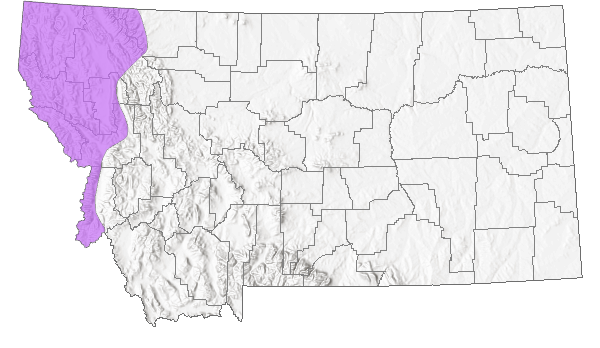
 Native
Native
Range Comments
In MT in Sanders, Madison, Teton and Ravalli counties; BC south to CA and ID (Lesica et al. 2012. Manual of Montana Vascular Plants. BRIT Press. Fort Worth, TX; Herbarium specimen data provided by University of Washington, University of Idaho, and Montana State University (accessed through the Consortium of Pacific Northwest Herbaria website, www.pnwherbaria.org, 2010-10-02)).
Observations in Montana Natural Heritage Program Database
Number of Observations: 9
(Click on the following maps and charts to see full sized version)
Map Help and Descriptions
Relative Density
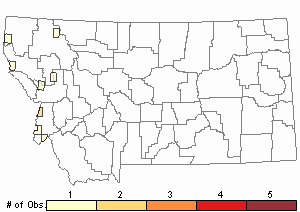
Recency
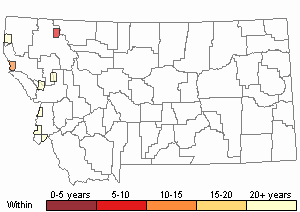

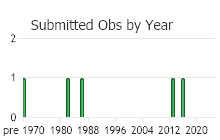
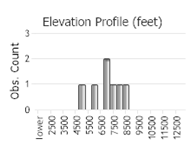 (Observations spanning multiple months or years are excluded from time charts)
(Observations spanning multiple months or years are excluded from time charts)
Habitat
Rocky subalpine areas in relatively moist areas of the Rockies, typically on igneous rocks (granite or extrusive types), and often in microsites with substantial winter snowpack (Alverson 1989). Habitats of Montana specimens include talus slopes, cliffs, and sites near boulders (Lesica 2012, CPNWH 2017).
National Vegetation Classification System Groups Associated with this Species
Alpine
Alpine - Sparse and Barren
Sparse and Barren
Sparse and Barren
Ecology
While C. acrostichoides is adapted to survive dry periods, (fronds become curled and brittle and then rehydrate with the reappearance of moisture), C. cascadensis apparently is not, because when water was withheld in a garden setting its fronds withered and died (Alverson 1989). With its thin, deciduous leaves, this species seems well-adapted to long, snowy winters, followed by relatively moist conditions during the growing season (Alverson 1989).
Processes that affect plants growing on talus slopes include erosion and deposition, rockfalls, and avalanches (Perez 2012). Large cobbles are substantially more stable than smaller-diameter substrates, and retain more moisture near the surface (Perez 2012). In many talus plants, most belowground biomass grows uphill, perhaps due to gradual burial as sediment creeps downhill (Perez 2012). Plants may adapt to these harsh conditions by growing close to the ground, minimizing exposure to geological hazards (Perez 2012). Most talus plants are perennials, and many are able to reproduce vegetatively – an advantage when growing on these shifting surfaces (Perez 2012).
Reproductive Characteristics
Spore sacs are in round to oblong clusters that are covered by the curled-under margins of the fertile leaves. When mature, these clusters (sori) merge (Alverson 1989; Alverson 1993).
Stewardship Responsibility
Threats or Limiting Factors
STATE THREAT SCORE REASON
Threat impact not assigned because threats are not known (MTNHP Threat Assessment 2021).
References
- Literature Cited AboveLegend:
 View Online Publication
View Online Publication Alverson, E. R. 1993. Cryptogramma. In Flora of North America Editorial Committee (ed). Flora of North America Volume 2: Pteridophytes and Gymnosperms. New York: Oxford University Press. 475 p.
Alverson, E. R. 1993. Cryptogramma. In Flora of North America Editorial Committee (ed). Flora of North America Volume 2: Pteridophytes and Gymnosperms. New York: Oxford University Press. 475 p. Alverson, Edward R. 1989. 'Cryptogramma cascadensis, a New Parsley-Fern from Western North America'. American Fern Journal. 79 (3).
Alverson, Edward R. 1989. 'Cryptogramma cascadensis, a New Parsley-Fern from Western North America'. American Fern Journal. 79 (3). eFloras. 2017. Flora of North America. Missouri Botanical Garden, St. Louis, MO & Harvard University Herbaria, Cambridge, MA.
eFloras. 2017. Flora of North America. Missouri Botanical Garden, St. Louis, MO & Harvard University Herbaria, Cambridge, MA. Harvey, T. 2015. Distinguishing Parsley Ferns (Cryptogramma spp.). Fall Creek, OR.
Harvey, T. 2015. Distinguishing Parsley Ferns (Cryptogramma spp.). Fall Creek, OR. Lesica, P., M.T. Lavin, and P.F. Stickney. 2012. Manual of Montana Vascular Plants. Fort Worth, TX: BRIT Press. viii + 771 p.
Lesica, P., M.T. Lavin, and P.F. Stickney. 2012. Manual of Montana Vascular Plants. Fort Worth, TX: BRIT Press. viii + 771 p. MTNHP Threat Assessment. 2021. State Threat Score Assignment and Assessment of Reported Threats from 2006 to 2021 for State-listed Vascular Plants. Botany Program, Montana Natural Heritage Program, Helena, Montana.
MTNHP Threat Assessment. 2021. State Threat Score Assignment and Assessment of Reported Threats from 2006 to 2021 for State-listed Vascular Plants. Botany Program, Montana Natural Heritage Program, Helena, Montana. Perez, F. L. 2012. Biogeomorphological influence of slope processes and sedimentology on vascular talus vegetation in the southern Cascades, California. Geomorphology 138:29-48.
Perez, F. L. 2012. Biogeomorphological influence of slope processes and sedimentology on vascular talus vegetation in the southern Cascades, California. Geomorphology 138:29-48.
- Additional ReferencesLegend:
 View Online Publication
View Online Publication
Do you know of a citation we're missing? Consortium of Pacific Northwest Herbaria (CPNWH) Specimen Database. No Date. Plant specimen data displayed on the PNW Herbaria portal. Website http://www.pnwherbaria.org.
Consortium of Pacific Northwest Herbaria (CPNWH) Specimen Database. No Date. Plant specimen data displayed on the PNW Herbaria portal. Website http://www.pnwherbaria.org. Lesica, P., M.T. Lavin, and P.F. Stickney. 2022. Manual of Montana Vascular Plants, Second Edition. Fort Worth, TX: BRIT Press. viii + 779 p.
Lesica, P., M.T. Lavin, and P.F. Stickney. 2022. Manual of Montana Vascular Plants, Second Edition. Fort Worth, TX: BRIT Press. viii + 779 p.
- Web Search Engines for Articles on "Cascade Rockbrake"





